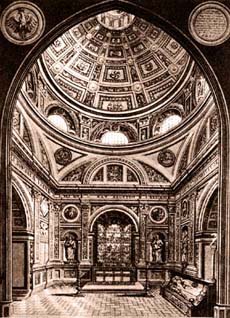|

The Marvel of the Renaissance Architecture in Krakow
The gold-plated
dome of the Sigismund Chapel crowns the best example of
Renaissance art and architecture with no match without Italy
and few equals within.
Bartolomeo
Berrecci of Florence built the chapel for King Sigismund I
the Old as a mausoleum for him and his family in the years
1519 to 1533. Every inch of its stone walls and dome is
covered with superbly sculptured, fine floral arabesques,
grotesque creatures and mythological scenes. The white of
walls heightens the deep red of marble statues of St. Peter,
St. Paul. St. Wenceslas, St. Florian, St. John the Baptist,
and St. Sigismund. The last statue compares with the best
Italian sculptures of the period. Medallion busts of the
Evangelists and King David and King Solomon above the six
saints are also of red marble. Opposite to the entrance
there is the king's stall with the 1574 tombstone of Queen
Anna Jagiello by Santi Gucci. On the left one can see
magnificent silver altarpiece with scenes from the Virgin
Mary's life wrought by Europe's then top masters in
Nuremberg in 1531-38. Its moveable wings are covered outside
with beautifully painted scenes from the Passion. The
altarpiece faces a sepulchral monument to King Sigismund I
the Old (above) and his son King Sigismund II Augustus
(beneath). Notably the sculpture of the former is
excellent.
The bronze
entrance grille made in Hans Vischer's famous Nuremberg
workshop in 1530-32 is an outstanding object of art itself.

Regular ticket price to the WAWEL CATHEDRAL
(plus the Zygmunt Bell and the Royal Tombs
as well as the Cathedral Museum)
is twelve zlotys
Monday-Saturday open to tourists 9.00 a.m. to
4.00 p.m.
On Sundays and Holidays open to tourists 12.30
p.m. to 4.00 p.m.
The Wawel Hill is accessible to visitors daily
since April through September from 6.00 a.m. to
8.00 p.m. and since October through March from
6.00 a.m. to 5.00 p.m. The Royal Castle's arcaded courtyard is off limits
half an hour before the closing time.
Exhibitions in the Royal Castle are closed on
Christmas, New Year's Day, Easter Sunday,
November 1 and November 11.
The following are permanent
exhibitions on the
Wawel Hill:
Royal Chambers - historical interiors, tapestry
collection of Sigismund II Augustus, royal
portraits, Italian Renaissance furniture,
Italian and Dutch painting of the 14th to 17th
century.
Crown Treasury and Armory
- regalia, jewelry, precious weapons, armors and
caparisons; Polish and West European.
Oriental Art - Turkish tents
and banners, Turkish and Persian weapons and
carpets, Chinese and Japanese ceramics.
The Lost Wawel - archaeological
and architectural reserve of the early
11th-century church of St. St. Felix and
Adauctus' with surroundings; objects excavated
by archeologists on the Wawel Hill; ornate stove
tiles of the 16th and 17th century. Plus
multimedia presentation of the Wawel Hill's
history.
Dragon's Den - big
cave said to be the fiery monster's
hideout.
Visitors can also see various
temporary exhibitions.
Admission terms and fees might be
subject to changes. For inquiries and booking
please contact the Tourist Service Office (BOT),
Wawel 5, 31-001 Kraków, Poland, tel.: (+48 12)
4225155 ext. 291, tel./fax: (+48 12) 4221697
|
Wawel Hill
Wawel Hill in Krakow, the mecca of every Pole and a
must for foreign tourists, is a microcosm of Polish history and
culture.Wawel Cathedral
Poland's impressive national shrine shelters plenty of
superb church art.
Cathedral Museum
Wawel Royal Castle
Home to three dynasties of Poland's monarchs. Its
stately halls and exquisite chambers are filled with priceless
art, best period furniture and rare ancient objects. The
collection of the 16th-century monumental Flemish tapestries is
matchless.
Royal Tombs
Poland's medieval rulers are buried under their
sarcophagi in the Cathedral's nave. Visitors can also see crypts
with the tombs of the Renaissance and later monarchs.
Great Bell
Giant Zygmunt bell is a third heavier and 350 years
older than its famed London cousin, the Big Ben.
Black Christ's Crucifix
650-year-old, 13-foot-tall remarkable sculpture of the
Savior provided guidance to Queen-Saint Jadwiga in the 14th
century and has heard prayers of the faithful ever since.
Other
Krakow Curios:
Prettiest Leonardo
da Vinci
World's greatest
medieval sculpture
Window of awe
Subterranean
wonder world
Giant bell
Miraculous images
8-foot golden
crown
Signal trump
Nativity beauties
Krakow mummies
Ice-age rhino
God of Slavs
Kmita's chasuble
|




